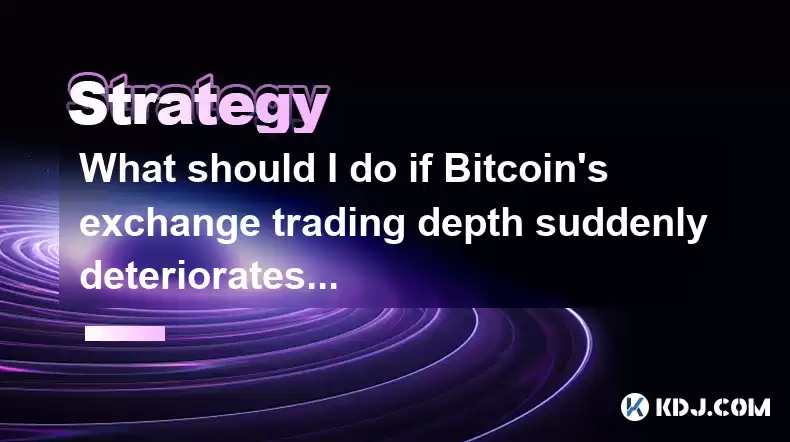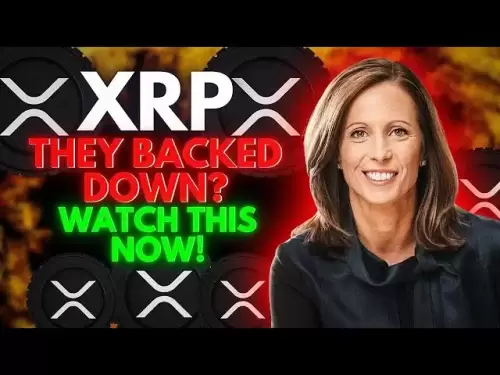-
 Bitcoin
Bitcoin $117500
2.15% -
 Ethereum
Ethereum $3911
6.19% -
 XRP
XRP $3.316
10.79% -
 Tether USDt
Tether USDt $1.000
0.01% -
 BNB
BNB $787.2
2.24% -
 Solana
Solana $175.2
4.15% -
 USDC
USDC $0.9999
0.00% -
 Dogecoin
Dogecoin $0.2225
8.40% -
 TRON
TRON $0.3383
0.28% -
 Cardano
Cardano $0.7868
6.02% -
 Stellar
Stellar $0.4382
9.34% -
 Hyperliquid
Hyperliquid $40.92
7.56% -
 Sui
Sui $3.764
7.63% -
 Chainlink
Chainlink $18.48
10.66% -
 Bitcoin Cash
Bitcoin Cash $582.1
1.88% -
 Hedera
Hedera $0.2601
6.30% -
 Avalanche
Avalanche $23.33
4.94% -
 Ethena USDe
Ethena USDe $1.001
0.02% -
 Litecoin
Litecoin $122.3
2.04% -
 UNUS SED LEO
UNUS SED LEO $8.969
-0.27% -
 Toncoin
Toncoin $3.339
0.86% -
 Shiba Inu
Shiba Inu $0.00001287
4.30% -
 Uniswap
Uniswap $10.43
7.38% -
 Polkadot
Polkadot $3.861
5.08% -
 Dai
Dai $1.000
0.02% -
 Bitget Token
Bitget Token $4.513
3.41% -
 Monero
Monero $267.7
-6.18% -
 Cronos
Cronos $0.1499
4.14% -
 Pepe
Pepe $0.00001110
5.15% -
 Aave
Aave $284.9
8.28%
What should I do if Bitcoin's exchange trading depth suddenly deteriorates?
If Bitcoin's trading depth deteriorates, assess the situation, adjust your strategy, diversify across exchanges, and monitor market changes to protect your investments.
Apr 19, 2025 at 01:57 am

If Bitcoin's exchange trading depth suddenly deteriorates, it can be a concerning situation for traders and investors. Trading depth, or the order book depth, refers to the total volume of buy and sell orders at different price levels within an exchange. When the depth deteriorates, it means there are fewer orders, which can lead to higher volatility and slippage. Here’s a detailed guide on what you should do if you encounter this situation.
Understanding Trading Depth Deterioration
Trading depth deterioration occurs when the number of orders in the order book decreases, resulting in a thinner market. This can happen due to various reasons such as market uncertainty, large trades, or withdrawal of liquidity by market makers. A thinner market can lead to increased volatility as fewer orders are available to absorb large trades, causing prices to move more drastically.
Assessing the Situation
Before taking any action, it’s crucial to assess the situation thoroughly. Start by checking multiple exchanges to see if the deterioration is isolated to one platform or a widespread issue. Use tools like CoinMarketCap or TradingView to monitor the order book depth across different exchanges. If the issue is isolated, it might be due to exchange-specific problems like technical issues or regulatory concerns.
Adjusting Your Trading Strategy
When faced with a deteriorated trading depth, you need to adjust your trading strategy to minimize risks. Consider the following steps:
- Reduce Position Sizes: With less liquidity, larger trades can significantly impact the market. Reducing your position sizes can help mitigate the risk of slippage.
- Use Limit Orders: Instead of market orders, use limit orders to control the price at which your trades are executed. This can help you avoid the volatility caused by a thin order book.
- Increase Slippage Tolerance: If you must use market orders, consider increasing your slippage tolerance to ensure your trades are executed, albeit at potentially less favorable prices.
Diversifying Across Exchanges
To mitigate the risk of trading on an exchange with deteriorating depth, diversify your trades across multiple exchanges. This strategy can help you take advantage of better liquidity on other platforms. Here’s how you can diversify effectively:
- Research Exchanges: Look for exchanges with strong liquidity and a good reputation. Consider factors like trading volume, security measures, and user reviews.
- Set Up Accounts: Create accounts on multiple exchanges. Ensure you complete all necessary verification processes to avoid delays when you need to trade.
- Distribute Your Assets: Allocate your Bitcoin and other cryptocurrencies across these exchanges. This not only spreads the liquidity risk but also protects against the potential failure of a single exchange.
Monitoring and Reacting to Market Changes
Monitoring the market closely is essential when dealing with deteriorated trading depth. Use real-time data and alerts to stay informed about changes in the order book. Here’s how you can effectively monitor and react:
- Set Up Alerts: Use trading platforms or third-party tools to set up price and volume alerts. This can help you react quickly to any significant changes in market conditions.
- Stay Informed: Follow cryptocurrency news and analysis from reputable sources. Understanding the broader market context can help you anticipate and react to changes in trading depth.
- Be Ready to Act: Have a clear plan for what actions to take if the situation worsens. This might include exiting positions, moving assets to other exchanges, or temporarily halting trading.
Protecting Your Investments
In addition to adjusting your trading strategy, protecting your investments is crucial when dealing with deteriorated trading depth. Consider these steps:
- Use Stop-Loss Orders: Implementing stop-loss orders can help limit your losses if the market moves against you. However, be aware that in a thin market, stop-loss orders might be executed at less favorable prices.
- Secure Your Assets: Ensure your cryptocurrencies are stored securely. Use hardware wallets for long-term storage and only keep the amount you need for trading on exchanges.
- Diversify Your Portfolio: Don’t put all your eggs in one basket. Diversify your cryptocurrency holdings to spread risk. This can include investing in other cryptocurrencies or even traditional assets.
Seeking Professional Advice
If you’re unsure about how to handle the situation, seeking professional advice can be beneficial. Financial advisors or experienced traders who specialize in cryptocurrencies can provide personalized guidance based on your specific situation. They can help you develop a robust strategy to navigate the challenges of a deteriorated trading depth.
Frequently Asked Questions
Q: Can trading depth deterioration be predicted?
A: While it’s difficult to predict with certainty, certain indicators like sudden drops in trading volume, increased volatility, or news about regulatory actions can hint at potential deterioration. Monitoring these signs can help you prepare for possible changes in trading depth.
Q: How does trading depth affect the price of Bitcoin?
A: Trading depth directly impacts Bitcoin’s price stability. A deep order book with many orders at various price levels can absorb large trades without significant price changes. Conversely, a thin order book can lead to higher volatility as fewer orders are available to cushion price movements.
Q: Is it safe to continue trading on an exchange with deteriorated trading depth?
A: It’s generally riskier to trade on an exchange with deteriorated trading depth due to increased volatility and potential for slippage. If possible, consider moving your trades to an exchange with better liquidity. If you must continue trading on the affected exchange, adjust your strategy to minimize risks.
Q: How can I measure trading depth on an exchange?
A: You can measure trading depth by looking at the order book on the exchange’s trading platform. Most platforms display the total volume of buy and sell orders at different price levels. Additionally, tools like CoinMarketCap or TradingView provide detailed order book data for various exchanges.
Disclaimer:info@kdj.com
The information provided is not trading advice. kdj.com does not assume any responsibility for any investments made based on the information provided in this article. Cryptocurrencies are highly volatile and it is highly recommended that you invest with caution after thorough research!
If you believe that the content used on this website infringes your copyright, please contact us immediately (info@kdj.com) and we will delete it promptly.
- Tron's Sell-Off Spurs Altcoin Shift: What's Next for TRX?
- 2025-08-08 08:30:12
- RUVI Presale: Is the Growth Potential Real?
- 2025-08-08 09:10:12
- Sleep Token's US Takeover: Thornhill Rides the 'Even In Arcadia' Wave
- 2025-08-08 08:30:12
- FTT Token's Wild Ride: Creditor Repayments vs. Market Drop - A New Yorker's Take
- 2025-08-08 07:10:12
- Floki Crypto Price Prediction: Riding the Robinhood Rocket or Just a Meme?
- 2025-08-08 07:15:12
- EigenLayer, Restaking, and Ethereum: Navigating the Hype and the Hazards
- 2025-08-08 06:30:12
Related knowledge

How to read cryptocurrency charts and use technical analysis?
Aug 08,2025 at 11:08am
Understanding the Basics of Cryptocurrency ChartsCryptocurrency charts are graphical representations of price movements over time. These charts are es...

How to avoid common crypto investment mistakes?
Jul 13,2025 at 01:35am
Understanding the Risks of Crypto InvestmentInvesting in cryptocurrency can be highly rewarding, but it also comes with significant risks. One of the ...

What is a long-short crypto strategy?
Jul 15,2025 at 10:56am
Understanding the Basics of a Long-Short Crypto StrategyA long-short crypto strategy is an investment approach where traders simultaneously take long ...

What is a long-short crypto strategy?
Jul 11,2025 at 01:28pm
Understanding the Basics of Long-Short Crypto StrategyA long-short crypto strategy is an investment approach where traders take both long and short po...

How to use the RSI indicator for crypto?
Jul 12,2025 at 03:56pm
Understanding the RSI Indicator in Cryptocurrency TradingThe Relative Strength Index (RSI) is a momentum oscillator used to measure the speed and chan...

Is copy trading a good strategy for crypto beginners?
Jul 12,2025 at 08:28am
Understanding Copy Trading in the Cryptocurrency MarketCopy trading is a strategy where novice traders replicate the trades of experienced investors a...

How to read cryptocurrency charts and use technical analysis?
Aug 08,2025 at 11:08am
Understanding the Basics of Cryptocurrency ChartsCryptocurrency charts are graphical representations of price movements over time. These charts are es...

How to avoid common crypto investment mistakes?
Jul 13,2025 at 01:35am
Understanding the Risks of Crypto InvestmentInvesting in cryptocurrency can be highly rewarding, but it also comes with significant risks. One of the ...

What is a long-short crypto strategy?
Jul 15,2025 at 10:56am
Understanding the Basics of a Long-Short Crypto StrategyA long-short crypto strategy is an investment approach where traders simultaneously take long ...

What is a long-short crypto strategy?
Jul 11,2025 at 01:28pm
Understanding the Basics of Long-Short Crypto StrategyA long-short crypto strategy is an investment approach where traders take both long and short po...

How to use the RSI indicator for crypto?
Jul 12,2025 at 03:56pm
Understanding the RSI Indicator in Cryptocurrency TradingThe Relative Strength Index (RSI) is a momentum oscillator used to measure the speed and chan...

Is copy trading a good strategy for crypto beginners?
Jul 12,2025 at 08:28am
Understanding Copy Trading in the Cryptocurrency MarketCopy trading is a strategy where novice traders replicate the trades of experienced investors a...
See all articles

























































































